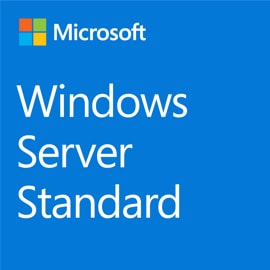AED 3,340.00 excl. VAT
5 in stock
Microsoft Windows Server 2022 Standard 16-Core OEM – P73-08328
Overview
Windows Server 2022 Standard from Microsoft is the platform for building an infrastructure of connected applications, networks, and web services, from the workgroup to the data center. It bridges on-premises environments with Azure, adding additional layers of security while helping you modernize your applications and infrastructure.
Advanced Multilayer Security
- Harden server communications – industry standard SMB AES -256 encryption and better controls
- Get preventative defense for sensitive assets like credentials with Credential Guard and Secure Boot enabled using TPM 2.0
- Protect system integrity from firmware attack with Windows Defender System Guard and isolate critical parts of the system with Virtualization-based security
Hybrid Capabilities with Azure Arc
- Extend Azure management and governance services to Windows Server on-premises using Azure Arc
- Perform virtual machine (VM) lifecycle management for your Azure Stack HCI and VMware environments from a centralized location
- Bring the first cloud native SIEM to all your resources by using Microsoft Sentinel through Azure Arc
Flexible Application Platform
- Improve container application deployment with smaller image size for faster download and simplified authentication
- Scale containerized applications with Kubernetes using improvements in network policy implementation and integration with industry standard containers
- Accelerate modernization of .NET applications
What’s New In Windows Server 2022
Security
Secured-Core Server
Hardware Root-of-Trust
Firmware Protection
UEFI Secure Boot
Virtualization-Based Security (VBS)
HVCI uses VBS to significantly strengthen code integrity policy enforcement. Kernel mode integrity prevents unsigned kernel mode drivers or system files from being loaded into system memory.
Kernel Data Protection (KDP) provides read-only memory protection of kernel memory containing non-executable data where memory pages are protected by Hypervisor. KDP protects key structures in the Windows Defender System Guard runtime from being tampered.
Transport: HTTPS and TLS 1.3 Enabled by Default on Windows Server 2022
Although TLS 1.3 in the protocol layer is now enabled by default, applications and services also need to actively support it. The Microsoft Security blog has more detail in the post Taking Transport Layer Security (TLS) to the next level with TLS 1.3.
Secure DNS: Encrypted DNS Name Resolution Requests with DNS-over-HTTPS
Server Message Block (SMB): SMB AES-256 Encryption for the Most Security Conscious
SMB: East-West SMB Encryption Controls for Internal Cluster Communications
SMB Direct and RDMA Encryption
Azure Hybrid Capabilities
Azure Arc Enabled Windows Servers
Windows Admin Center
Application Platform
Some of the new features are:
- Reduced Windows Container image size by up to 40%, which leads to a 30% faster startup time and better performance.
- Applications can now use Azure Active Directory with group Managed Services Accounts (gMSA) without domain joining the container host. Windows Containers now also support Microsoft Distributed Transaction Control (MSDTC) and Microsoft Message Queuing (MSMQ).
- Simple buses can now be assigned to process-isolated Windows Server containers. Applications running in containers that need to talk over SPI, I2C, GPIO, and UART/COM are now able to do so.
- Microsoft has enabled support for hardware acceleration of DirectX APIs in Windows containers to support scenarios such as Machine Learning (ML) inference using local graphical processing unit (GPU) hardware. For more information, see the Bringing GPU acceleration to Windows containers blog post.
- There are several other enhancements that simplify the Windows Container experience with Kubernetes. These enhancements include support for host-process containers for node configuration, IPv6, and consistent network policy implementation with Calico.
- Windows Admin Center has been updated to make it easy to containerize .NET applications. Once the application is in a container, you can host it on Azure Container Registry to then deploy it to other Azure services, including Azure Kubernetes Service.
- With support for Intel Ice Lake processors, Windows Server 2022 supports business-critical and large-scale applications that require up to 48TB of memory and 2048 logical cores running on 64 physical sockets. Confidential computing with Intel Secured Guard Extension (SGX) on Intel Ice Lake improves application security by isolating applications from each other with protected memory.
Task Scheduler and Hyper-V Manager for Server Core Installations
Nested Virtualization for AMD Processors
Microsoft Edge Browser
UDP Performance Improvements
TCP Performance Improvements
Hyper-V Virtual Switch Improvements
System Insights Disk Anomaly Detection
Disk anomaly detection is a new capability that highlights when disks are behaving differently than usual. While different isn’t necessarily a bad thing, seeing these anomalous moments can be helpful when troubleshooting issues on your systems. This capability is also available for servers running Windows Server 2019.
Windows Update Rollback Improvements
This functionality requires the server to be using the Server Core installation option with a Windows Recovery Environment partition.
Storage Migration Service
- Migrate local users and groups to the new server.
- Migrate storage from failover clusters, migrate to failover clusters, and migrate between standalone servers and failover clusters.
- Migrate storage from a Linux server that uses Samba.
- More easily synchronize migrated shares into Azure by using Azure File Sync.
- Migrate to new networks such as Azure.
- Migrate NetApp CIFS servers from NetApp FAS arrays to Windows servers and clusters.
Adjustable Storage Repair Speed
Faster Repair and Resynchronization
Storage Bus Cache with Storage Spaces on Standalone Servers
ReFS File-Level Snapshots
SMB Compression
Published on lastbestprice.com
Be the first to review “Microsoft Windows Server 2022 Standard 16-Core OEM – P73-08328”
Related products
Microsoft
Microsoft Windows GGWA Windows 10 Professional Legalization GetGenuine – DG7GMGF0CGSH:0005
Microsoft
Microsoft Windows Server 2022 Remote Desktop Services External Connector – DG7GMGF0D609:0002













































Reviews
There are no reviews yet.